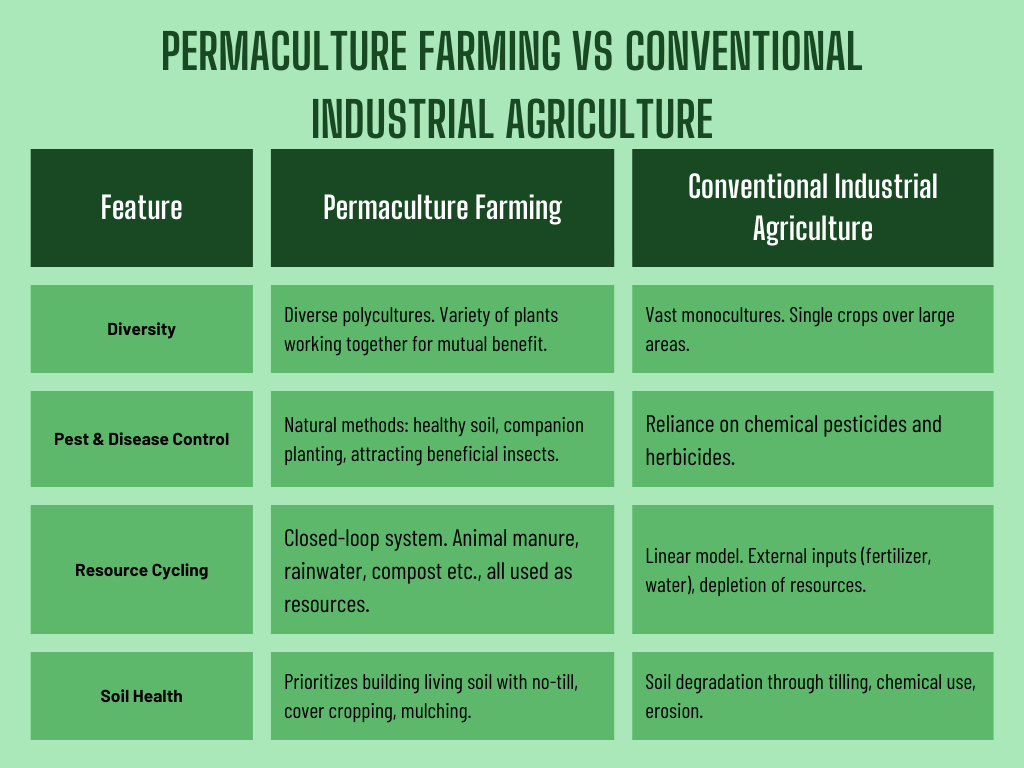Imagine a world where your garden nourishes not only your family but also the soil. It replenishes the water table, and invites thriving biodiversity. It’s not too good to be true. Permaculture, an approach to agriculture and community design, seeks to make this vision a reality.
By working with nature’s rhythms and cycles, it promises a more sustainable food system. The thing is cutting-edge technologies like data analytics are unlocking new levels of efficiency and resilience within permaculture, taking the concept to new heights.
What is Permaculture
Permaculture is a design philosophy inspired by the wisdom of natural ecosystems. Its founders, Bill Mollison, and David Holmgren, observed how forests and wetlands produce abundance year after year without fertilizers, pesticides, or constant human intervention. Permaculture aims to translate those patterns into human systems that are both productive and regenerative.
The name “permaculture” merges the concepts of “permanent” and “agriculture,” and while food production is central to this concept, it expands to how we design our homes, communities, and economies for a truly sustainable future.
Know that, permaculture integrates land, resources, people, and the environment through mutually beneficial synergies – imitating the no waste, closed loop systems seen in diverse natural systems.
The Magic of Permaculture Farming
Permaculture farming is not like anything that happened before. That is because, instead of vast fields of a single crop, permaculture embraces diverse mixtures of plants, fostering a balanced ecosystem.
It also relies on natural predators, companion planting, and healthy soil to keep harmful bugs in check. Moreover, it thrives on the belief that everything has a purpose – animal manure becomes fertilizer, rainwater feeds plants, and kitchen scraps turn into rich compost.
Not to mention, Permaculture emphasizes building healthy soil teeming with life, the very basis of a successful food system.
The Core Ethics of Permaculture
There are three guiding principles that live at the heart of all permaculture designs:
Care for the Earth
This principle includes everything from responsible land management to the promotion of biodiversity. What is its goal? It is to heal damaged landscapes, conserve water, support wildlife, reduce waste, and minimize pollution.
Care for People
You must know that in permaculture when we say care of people, it means human needs are at the core of a truly sustainable system. Which means, we must design food security, build just and equitable communities, create meaningful work opportunities, and foster well-being in general to be able to achieve our goals.
Fair Share (or Surplus Reinvestment)
Fair share is all about reinvesting excess resources into the system or giving them away. Seeds can be stored for next year, surplus food can be provided to people in need, and information and resources can be shared to encourage widespread adoption of permaculture practices.
Permaculture Design – The Principles of Permaculture
Permaculture design is about more than just where to plant a tree – it’s a comprehensive approach to creating systems that integrate with their surroundings. Here’s a deeper dive into its toolkit:
These guiding principles, developed by David Holmgren, inform permaculture designs at every scale:
- Observe and Interact: Spending time truly seeing your space – patterns of sun and shade, water flow, wildlife trails – is crucial before making changes.
- Catch and Store Energy: Harvesting and storing resources when they’re abundant. Examples include rainwater in tanks, sunlight through solar panels, or turning kitchen waste into compost.
- Obtain a Yield: Ensuring every element in your system provides a valuable return, whether it’s food, shelter, or ecosystem services like clean water.
- Apply Self-Regulation and Accept Feedback: Being open to learning from your system. If something isn’t working, adjust and observe the results.
- Use and Value Renewable Resources & Services: Emphasizing what nature freely offers – sunlight, wind, and the work of beneficial organisms in the soil.
- Produce No Waste: Viewing everything as a potential resource. Using food scraps for compost, fallen leaves as mulch, and finding creative uses for excess produce.
- Design from Patterns to Details: Understanding broad patterns in nature (spirals, branching systems) to inform designs, then filling in the specifics.
- Integrate Rather Than Segregate: Combining elements so they support each other, like chickens under fruit trees for pest control and fertilization.
- Use Small and Slow Solutions: Starting small, observing, and scaling up successful elements saves time, energy, and resources eventually.
- Use and Value Diversity: Diverse systems are more resilient. Mixing plant and animal species, growing multiple crop varieties, and creating varied microclimates.
- Use Edges and Value the Marginal: Where two ecosystems meet (like forest and meadow) is often the most dynamic and productive area.
Common Permaculture Techniques
Here are techniques to help enact these principles:
- Zoning: Placing elements based on need, frequency of use, and energy flow.
- Sector Analysis: Mapping external influences like wind, sun, fire hazards, and views.
- Sheet Mulching: Building new, fertile soil on top of poor, compacted areas with layers of cardboard, compost, and mulch.
- Swales: Trenches on contour (level with the land) to slow water flow, allowing it to soak into the soil rather than running off.
- Food Forests: Mimicking natural forests with diverse layers of edible and useful plants.
- Keyhole Beds: Circular raised beds with a composting center for easy access and efficient water use.
- Hugelkultur: Raised beds built over buried wood that become sponge-like reservoirs of water and nutrients as the wood decays.
- Integrated Animal Systems: Managing chickens, goats, or livestock to rotate through areas needing weeding, pest control, or fertilization.
How Does Permaculture Design Process Look
Permaculture design is a process, not a single layout. Here’s how it might look:
- Observation: Months of noting sun patterns, soil, plants, water flow, wind, etc.
- Broad Goals: Food, biodiversity, water conservation, reduced waste, etc.
- Zoning/Sector Analysis: Creates an initial basic map.
- Specific Techniques: Sheet mulch to start a garden, swales to manage rain, keyhole beds for veggies.
- Implementation in Stages: Start small, expand successful elements, adjust as needed.
Remember, Permaculture empowers you to create unique, site-specific solutions. It’s a journey of learning and working with nature – there’s always something new to discover!
Permaculture Examples
Permaculture adapts to any climate and scale – here’s a taste of its potential:
Konga Institute
Permaculture practices are not always used directly on farms. The Konga Institute is in New Zealand, one of the purest places on Earth, and houses the world’s largest organic seed market.
The Konga Institute is particularly well-known for educating students and instructors about the value of permaculture, as its seminars are aimed at anyone who is interested in sustainable living and wants to urge their own communities to do the same.
Happy Food Farm
Happy Food Farm is headquartered in Nanning, China, and produces a wide range of vegetables, flowers, fish, and fowl. This farm is permaculture because they feed their cattle their own fruits and veggies, reducing waste. They are also passionate about teaching the benefits of permaculture to the children in their community so that the future generation can apply it more easily.
IDEP Foundation
This non-profit organization established in Bali is dedicated to training people interested in sustainable development through permaculture approaches. IDEP educates their local communities about the necessity of permaculture, the impact of natural catastrophes, and how to respond to climate change and rebuild using permaculture principles.
Permaculture in Ukraine
Another non-profit organization committed to permaculture in Ukraine, this NGO aims to develop a collective effort to implement permaculture techniques in the houses of their local communities and urge others to follow suit.
Chiefly, the ultimate purpose of Permaculture in Ukraine is to help others in society comprehend the value of permaculture, with an emphasis on identifying the appropriate permaculture activities to take based on the requirements of the local community.
Permaculture Association of South Australia
This Australian non-profit organization strives to promote permaculture concepts in South Australia by focusing on caring for nature and people while limiting the consumption of vital resources. PASA aims to promote permaculture throughout Southern Australia.
Permaculture Farming Vs Conventional Industrial Agriculture
Evidently, permaculture farms look and function very differently from conventional industrial agriculture. Here is how:

How Can Permaculture Be Even More Sustainable Through Data Analytics?
Permaculture already emphasizes working with natural systems, mimicking their interconnectedness and efficiency. Now, imagine adding a high-tech lens to those principles.
Like Transforming Patient Care Through Predictive Analytics And Personalized Medicine, using data analytics, permaculture practitioners can gain insights and fine-tune their systems like never before. Here’s how:
Precision Monitoring for Efficient Resource Use
Soil sensors transform the way we interact with the ground beneath our feet. These devices provide real-time readings on key factors like moisture, pH, and nutrient levels. Instead of relying on guesswork or general watering schedules, permaculture practitioners can precisely gauge when and where resources are needed.
This translates to healthier plants, optimized yields, and the prevention of water waste or overfertilization that can harm the delicate soil ecosystem. It’s like having a stethoscope constantly monitoring the health of your soil.
Moreover, Hyper-local weather monitoring elevates permaculture design through sensors that track temperature, humidity, wind, and rainfall. Understanding these microclimates on a granular level empowers several key benefits. Crop choices become finely tuned – a difference of a few degrees can make or break a particular plant variety.
Further, pests, often triggered by specific weather conditions, can be anticipated, and preventative measures can be implemented. Rainfall patterns inform water harvesting strategies, maximizing capture and utilization of this precious resource.
In addition, Wearable tech and implantable sensors are changing the way we monitor plant and animal health in permaculture. These tiny sentinels can detect subtle changes indicating preliminary stages of disease or stress, long before visible symptoms appear.
This is crucial because timely intervention can often safeguard yields and prevent the spread of disease to other plants or animals. Moreover, it empowers the permaculture practitioner to be proactive rather than reactive, ensuring the long-term health and productivity of their integrated system.
Data-Driven Design for Optimal Layouts and Yields
3D modeling software transforms permaculture design by visualizing the hidden forces influencing a site. It considers topography, slopes, existing structures, and potential new elements to paint a dynamic picture of sun exposure, shade patterns, and wind flows.
The impressive thing about it is that the detailed analysis allows for informed choices. But what are those informed decisions?
Placing sun-loving plants in the most favorable locations, designing buildings to take advantage of passive solar heating or cooling, and strategically locating swales and ponds based on water flow patterns.
Additionally, Simulation software acts as a virtual testbed for permaculture systems. By combining historical weather data, soil information, and specific crop characteristics, it predicts potential yields under different scenarios.
Also, designers can experiment with different planting densities, experiment with polycultures to see how they’d fare together, and develop succession plans that keep the land productive year-round. This reduces risks, saves resources, and helps to optimize yields before a single seed is sown.
Moreover, Mapping overlays bring multiple data layers together, allowing designers to pinpoint optimal locations for various permaculture elements. By combining soil type, drainage patterns, and slope with potential design elements like food forests, ponds, or animal grazing areas, these tools reveal the most suitable and productive zones within a landscape.
The result is a design that makes the most efficient use of resources, maximizing the potential for success and minimizing the need for later interventions.
Pattern Recognition for Long-Term Resilience and Improvement
By meticulously tracking yields over time and correlating them with weather events (like heat waves or heavy rainfall) and management practices (such as compost application dates or planting spacing), permaculture practitioners gain invaluable insights into which crop varieties excel under specific conditions.
It is a data-driven approach that allows farmers to select the most resilient and productive plants for their unique microclimates.
Moreover, it illuminates which techniques, from companion planting schemes to soil amendment strategies, lead to the most bountiful harvests, empowering farmers to refine their approach for progressively better results with each growing season.
Furthermore, Data-powered Prevention Data analytics enables permaculture practitioners to be proactive rather than reactive when it comes to pests and diseases.
By analyzing historical patterns of outbreaks, they can pinpoint correlations with factors like weather conditions (humidity, temperature), plant health indicators (nutrient levels), and specific locations within the system.
Which means, early identification of potential risks and the implementation of preventative measures.
Examples include strategically choosing disease-resistant varieties, utilizing targeted companion planting, ensuring optimal soil health, or even adjusting irrigation timing to create less favorable conditions for the spread of pathogens.
Moreover, Designing for True Efficiency by tracking how essential resources like energy, water, nutrients, and materials flow through a permaculture system, practitioners can visualize the big picture with granular detail.
Besides, data analytics software can highlight bottlenecks, such as an area where excess water pools instead of being utilized or reveal where certain nutrients are not reaching their intended destination. This allows for pinpoint design modifications that increase the overall efficiency and closed-loop potential of the system.
It might lead to the strategic placement of swales to capture runoff, the alteration of a compost system for more balanced nutrient output, or changes in animal rotation to better distribute fertility.
Benefits Beyond the Individual Farm or Garden
When farmers and homesteaders pool the data they collect, it unveils insights that wouldn’t be visible from individual plots alone. They can analyze how permaculture practices collectively affect microclimates (temperature, humidity). Eventually, improving biodiversity by attracting specific species, and influence groundwater levels through rainwater retention.
This information paints a larger picture. It empowers regional planning that helps communities coordinate to maximize the benefits of permaculture for whole areas. The results? Efforts are complementary and effective.
Moreoever, data isn’t just for those with their hands in the soil. Showing consumers the tangible results of permaculture — less water used, more carbon captured – creates a powerful story.
Certainly, farmers and advocates can use this data to engage environmentally conscious consumers and build support for permaculture-grown food. Highlighting the positive impact of their buying choices empowers consumers to drive broader change. This imapct happens within the food system through their purchases.
Important Considerations for Premaculture
- Accessibility
The power of data analytics lies in making it accessible for permaculture practitioners of all levels. Along with developing affordable tools and providing clear training. This helps farmers and homesteaders gather and interpret their own data without requiring extensive technical backgrounds.
Before anothing else, simplifying the process will encourage broad participation and widespread adoption.
- Data Sovereignty
Data generated on permaculture farms and homesteads is an asset. It is crucial to establish systems to ensure that farmers retain full ownership and control over their data. This leads to transparency in how data is collected, stored, and potentially used. While also prioritizing models that empower farmers rather than ceding control to corporations or centralized entities.
- Holistic Approach
Permaculture emphasizes deep observation of nature’s patterns and understanding the unique needs of a particular site. Know that, data analytics should be a support tool within this process, rather than replacing it. Besides, the most effective solutions will emerge when the insights from data are combined with the intuitive knowledge. Also, close connection to the land that skilled permaculture practitioners cultivate.
The Future of Permaculture
Data analytics, in combination with permaculture’s core principles, holds the potential to transform food systems and land management globally. We’re on the cusp of an era where ancient wisdom and cutting-edge technology work together to create a sustainable future.
Basically, permaculture offers a pathway to where we work with nature; to grow food, nurture ecosystems, and build thriving communities. Moreover, with data analytics now in the mix, permaculture is set to become more efficient, adaptable, and accessible than ever before. The question isn’t just if permaculture can be more sustainable— the answer is a resounding yes!
RevSoft Today
Ready to revolutionize your business with innovative tech solutions and sustainable practices? Join the RevSoft community today and take the first step towards a brighter future!





